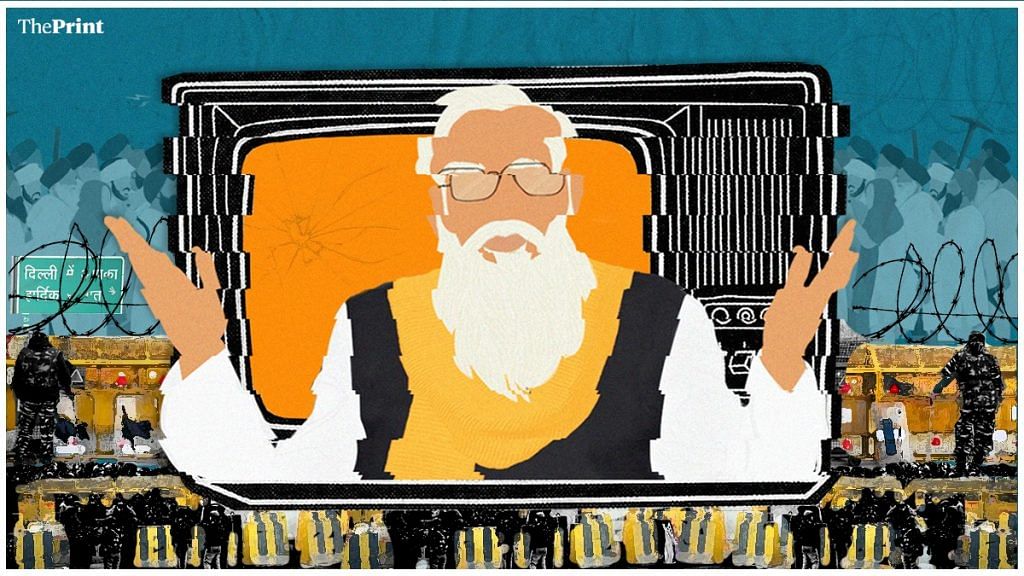Prime Minister Narendra Modi once ruled all political optics. He could do nothing wrong, which is why he could turn into a Bal Narendra who slew crocodiles, or become an exam warrior who sought to empower Indian students to face Boards and other examinations where the pressure to do well has made many children suicidal. Then, he was the Hindu Hriday Samrat, the fakir, the chaiwalla, the brother of all Muslim women sick of triple talaq, and so on and so forth. But all of a sudden, the farmer stir has given birth to a new crop of pop culture content that isn’t so kind to Modi.
Memes and images are now showing another story. Modi is losing the visuals war, be it cartoons depicting him as sowing a carpet of thorns for farmers, or journalists writing notes on their legs in prison. And when the fourth-most followed person on Twitter, Rihanna, tweets about the Indian government’s ban on the internet in areas where farmers are protesting, you know the world isn’t going to see this in the best light. Top it up with US Vice-President Kamala Harris’ niece Meena Harris, who is a very esteemed lawyer of the Supreme Court in America, also tweeting in support of the farmers, and you soon realise that PM Modi is getting widespread condemnation internationally.
The farmer protests have set up a new PR challenge for the Modi government.
His carefully constructed image of the chaiwalla-to-Lok Kalyan Marg journey is beginning to crack. Every day as new farmers join the protests, new memes are made and shared — be it the ones of Modi and Home Minister Amit Shah lounging and asking farmers to come talk, but offering them spikes to sit on, visuals of Modi being chased by tractors, #ModiNaukarAmbaniKa memes featuring Modi as the genie to Mukesh Ambani’s Alladin; or Modi watering nails that have been drilled into the roads of the Singhu border.
Also read: ‘Conspiracy to malign Indian tea’ — Modi takes dig at ‘Greta toolkit’ in Assam speech
Bad optics
The problem that is central to the Modi government getting all this flak is that it doesn’t understand how to deal with dissent. And whatever it does to silence dissent can be argued to have been taken from a handbook called ‘How to Not Deal with Dissent’. What ends up happening, as we have seen in many cases, is that people expressing dissent or displeasure against the government often get jailed. Many who have been jailed are journalists and activists.
Things have become so bleak that the United Nations Human Rights office tweeted calling for ‘maximum restraint’ to be shown by both the farmers as well as the Indian government during the ongoing farmers’ protest, asserting that rights to peaceful assembly and expression should be protected both offline and online. This, for a government that has come down heavily on protesters not only now, but also during the anti-CAA protests.
Although, those who are decidedly pro-Modi insist that the farm laws are a huge leap in disrupting the status quo of the centuries-old agricultural practices and is, therefore, not being accepted readily. But the fact is that many farmers are joining this protest, and the number of people standing against these laws is only growing exponentially. To curb violence of the kind that took place on 26 January, the Modi government is barricading national highways in a manner that makes it look iron-fisted and unwilling to listen to the voices of its people. With concrete structures getting built with iron nails in the middle of highways, memes are now dedicated to making fun of the Modi government’s strictness with its own country’s farmers, as opposed to how softly they have dealt with China’s incursions.
Also read: Time for Modi to play the elder statesman and repeal the farm laws
Attempts to discredit farmers
In spite of any blunders on part of any protesting farmer, the protests still enjoy a significant amount of sympathy from common citizens because of how farmers have often ordained an almost deity-like position in Indian society. How does one make them look anti-national? It is impossible.
In fact, using the anti-national and ‘Khalistani’ peg to prove the ‘ulterior motives’ of these farmers’ protests has had a boomerang-effect, since the protests are now driven by jats and not Sikhs. The stir in Uttar Pradesh is highlighting the administration’s heavy-handedness against those who speak against it, or Chief Minister Yogi Aditynath.
By stating that ‘Adani and Ambani’ are hand-in-glove with the government for bringing in corporate interests through these laws, the farmers are building a narrative that is hitting home with the Indian poor who are tired of being taken advantage of by the rich. It was this very sentiment, created by Modi’s chaiwalla, or ‘non-corrupt’ and ‘non-capitalistic fakir’ image, that had propelled the PM into the hearts and minds of the poor as their saviour. Demonetisation furthered that feeling of Modi being against the big businessmen and their pet politicians who hoarded swathes of black money.
But if Narendra Modi, at this point, doesn’t realise that the very things that made him popular are now being undone by policies that seem to make the rich richer and the poor poorer, he’s going to face a hard time. The visuals war is clearly not in favour of Modi right now, and the world is watching.
The author is a political observer and writer. Views are personal.
